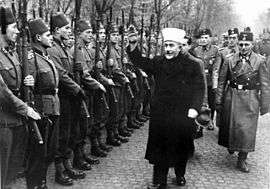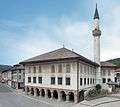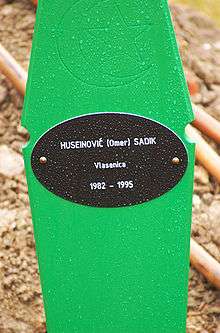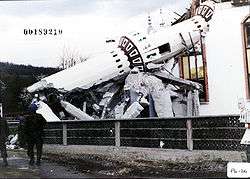Islam in Bosnia and Herzegovina
| Part of a series of articles on
|
| Bosniaks
|
|---|
.svg.png) |
|
Recognized |
|
Kinship · Architecture · Cultural Heritage Sites · Literature · Music (Sevdalinka) · Art · Cinema Cuisine · Sport |
Islam is the most widespread religion in Bosnia and Herzegovina. It was introduced to the local population in the 15th and 16th centuries as a result of the Ottoman conquest of Bosnia and Herzegovina.
The Bosniaks are predominantly Muslim by religion, for which reason they have also been emphasized as "Bosnian Muslims" throughout their history, a term which thus also implies ethnic belonging. Albeit traditionally adherent to Sunni Islam of the Hanafi school of jurisprudence, a 2012 survey found 54% of Bosnia and Herzegovina's Muslims to consider themselves non-denominational Muslims, while 38% declared to follow Sunnism.[1]
Muslims comprise the single largest religious community in Bosnia and Herzegovina (51%) (the other two large groups being Eastern Orthodox Christians (31%), of whom most identify as Serbs, and Roman Catholics (15%), of whom most identify as Croats).[2]
Minority groups of Muslims in Bosnia and Herzegovina include Albanians, Roma people and Turks.
The Ottoman and Austro-Hungarian era
Islam was first introduced to the Balkans on a large scale by the Ottomans in the mid-to-late 15th century who gained control of most of Bosnia in 1463, and seized Herzegovina in the 1480s. Over the next century, the Bosnians - composed of dualists and Slavic tribes living in the Bosnian kingdom under the name of Bošnjani [3] - embraced Islam in great numbers under Ottoman rule. During the Ottoman era the name Bošnjanin was definitely transformed into the current Bošnjak ('Bosniak'), with the suffix "-ak" replacing the traditional "-anin". By the early 1600s, approximately two thirds of the population of Bosnia were Muslim.[4] Bosnia and Herzegovina remained a province in the Ottoman Empire and gained autonomy after the Bosnian uprising in 1831. After the 1878 Congress of Berlin it came under the temporary control of Austria-Hungary. In 1908, Austria-Hungary formally annexed the region.
Bosnia, along with Albania, were the only parts of the Ottoman Empire in the Balkans where large numbers of people were converted to Islam, and remained there after independence. In other areas of the former Ottoman Empire where Muslims formed the majority or started to form the majority, those Muslims were either expelled, assimilated/Christianized, massacred, or fled elsewhere (Muhajirs).
WWII

Bosnian war

The ethnic cleansing of Bosnian Muslims during the Bosnian war caused a profound internal displacement of their population within Bosnia-Herzegovina, resulting in the almost complete segregation of the country's religious communities into separate ethno-religious areas. The rate of returning refugees was markedly slowed down by 2003-2004, leaving the majority of Serbian Orthodox adherents living in the Republika Srpska and the majority of Muslims and Catholics still living in the Federation of Bosnia and Herzegovina. Within the Federation, distinct Muslim and Catholic majority areas remain. However, the return of Serbian Orthodox adherents and Muslims to their prewar homes in Western Bosnia Canton and Muslims to their prewar homes in eastern Bosnia near Srebrenica have shifted the ethno-religious composition in both areas.
Throughout Bosnia, mosques were systematically destroyed by Serb and Croat armed forces. Among the most important losses were two mosques in Banja Luka, Arnaudija and Ferhadija mosque, that were on the UNESCO register of world cultural monuments.
Destruction of Islamic religious buildings in Bosnia 1992-1995
| Building | Destroyed | Damaged | Total | |||||||||||
|---|---|---|---|---|---|---|---|---|---|---|---|---|---|---|
| by Serb extremists | by Croat extremists | by Serb extremists | by Croat extremists | Total destroyed during the war | Total damaged during the war | Total | Total no. before the war | Percentage of pre-war damaged or destroyed | ||||||
| congregational mosque | 30 | 58 | 540 | 80 | 307 | 82 | 927 | 282' | 81% | |||||
| small neighbourhood mosque | 21 | 20 | 175 | 43 | 41 | 218 | 259 | 557 | 47% | |||||
| Quran schools | 14 | 4 | 55 | 14 | 18 | 69 | 87 | 954 | 9% | |||||
| Dervish lodges | 4 | 1 | 3 | 1 | 5 | 4 | 9 | 15 | 60% | |||||
| Mausolea, shrines | 6 | 1 | 34 | 3 | 7 | 37 | 44 | 90 | 49% | |||||
| Buildings of religious endowments | 125 | 24 | 345 | 60 | 149 | 77 | 5 | 1,425 | 39% | |||||
| Total | 419 | 108 | 1,152 | 201 | 527 | 1,353 | 1,880 | 4,190 | 45% | |||||
Increased religious identification
Religious leaders from the three major faiths claim that observance is increasing among younger persons as an expression of increased identification with their ethnic heritage, in large part due to the national religious revival that occurred as a result of the Bosnian war.[6] Many Muslim women have adopted Islamic dress styles that had not been common, especially in cities, before the war. Leaders from the three main religious communities observed that they enjoy greater support from their believers in rural areas of Bosnia and Herzegovina rather than urban centres such as the capital Sarajevo or Banja Luka.[6] In Bosnia and Herzegovina, there are eight Muftis located in major municipalities across the country: Sarajevo, Bihać, Travnik, Tuzla, Goražde, Zenica, Mostar, and Banja Luka. The acting head of the Islamic Community of Bosnia and Herzegovina is Husein Kavazović.[7]
In a 1998 public opinion poll, 78.3% of Bosniaks in the Federation of Bosnia and Herzegovina declared themselves to be religious.[8]
Secularism
For a majority of Bosniaks that identify themselves as Bosnian Muslims, religion often serves as a community linkage, and religious practice is confined to occasional visits to the mosque or significant rites of passage such as birth, marriage, and death. Headscarves for women, or the hijab is worn only by a minority of Bosniak women, and otherwise mostly for religious obligations. Bosnians who participate in or are children of ethnically mixed marriages between the Bosniak, Serb and Croat populations in Bosnia and Herzegovina are often irreligious.
Status of religious freedom
The State Constitution provides freedom of religion,[9] and individuals generally enjoy this right in ethnically mixed areas or in areas where they were adherents of the majority religion.
The government's census bureau today does not collect data on religious affiliation and the percentages given are the estimates in the U.N. Development Program's Human Development Report 2002 as quoted by the Bosnia and Herzegovina report.[10]
Wahhabism
Historically, the majority of Bosniaks peacefully practiced Islam, as the country was greatly influenced by Sufism. However, the country has recently became a fertile ground for Wahhabi militant activities and recruitment. Gulf countries such as Saudi Arabia and Qatar are sponsoring mosques, schools and other communal projects that spread Wahhabism. This causes conflict within the Bosniak society that has traditionally embraced non-Wahhabi Islam influenced by Sufism.[11][12]
See also
- Islamization of Bosnia and Herzegovina
- Bosniaks
- 13th Waffen Mountain Division of the SS Handschar (1st Croatian)
- Islam by country
- Persecution of Muslims
- Bosnian Church
- Pomaks
Gallery
-
.jpg)
Bosnian Madrasa ca. 1906
-
.jpg)
Mosque, Cazin, ca. 1906
-

Bosniak military imam in the Austro-Hungarian Army
-

Mosque, Travnik, constructed 1815
-

Gazi Husrev-beg madrasa, Sarajevo, constructed 1537
-
.jpg)
Baščaršija Mosque, Sarajevo, constructed 1561
-
Mosque, Počitelj, constructed 1561
-
Mosque, Mostar, constructed 1617
-
.jpg)
Wooden mosque, Tuzla, from the 18th century
-

Muslim gravestones at the Potočari genocide memorial near Srebrenica
-

Gravemarker of a 13-year-old Muslim boy killed in the Srebrenica massacre 1995
-

Mosque destroyed during the Ahmići massacre 1993
-
Post-war Islamic centre and mosque, Bugojno
-

Muslim cemetery, Sarajevo
-
.jpg)
Gazi Husrev-beg's Mosque
References
- ↑ "The World's Muslims: Unity and Diversity" (PDF). Pew Research Center. 2012. p. 30. Retrieved 7 April 2016.
- ↑ "CIA – The World Factbook – Bosnia and Herzegovina".
- ↑ Bašić, Denis (2009). The roots of the religious, ethnic, and national identity of the Bosnian-Herzegovinan [sic] Muslims. University of Washington. ISBN 9781109124637.
- ↑ Malcolm 1995, p. 71.
- ↑ Maya Shatzmiller (2002). Islam and Bosnia: Conflict Resolution and Foreign Policy in Multi-Ethnic States. Queens University School of Policy. p. 100.
- 1 2 "Bosnia and Herzegovina: International Religious Freedom Report 2006". U.S Department of State—Bureau of Democracy, Human Rights, and Labor. 2006-09-15.
- ↑ "Islamska zajednica u Bosni i Hercegovini - Početna". Retrieved 14 June 2016.
- ↑ Velikonja, Mitja (2003). Religious separation and political intolerance in Bosnia-Herzegovina. Texas A&M University Press. p. 261. ISBN 1585442267. Retrieved 6 January 2011.
- ↑ Freedom of religion Law..., Official Gazette of B&H 5/04
- ↑ "International Religious Freedom Report 2008". Bosnia and Herzegovina. United States Department of State.
- ↑ "Radical Islamists Seek To Exploit Frustration In Bosnia". Retrieved 14 June 2016.
- ↑ "Bosnia's Wartime Legacy Fuels Radical Islam :: Balkan Insight". Retrieved 14 June 2016.
External links
| Wikimedia Commons has media related to Islam in Bosnia and Herzegovina. |
